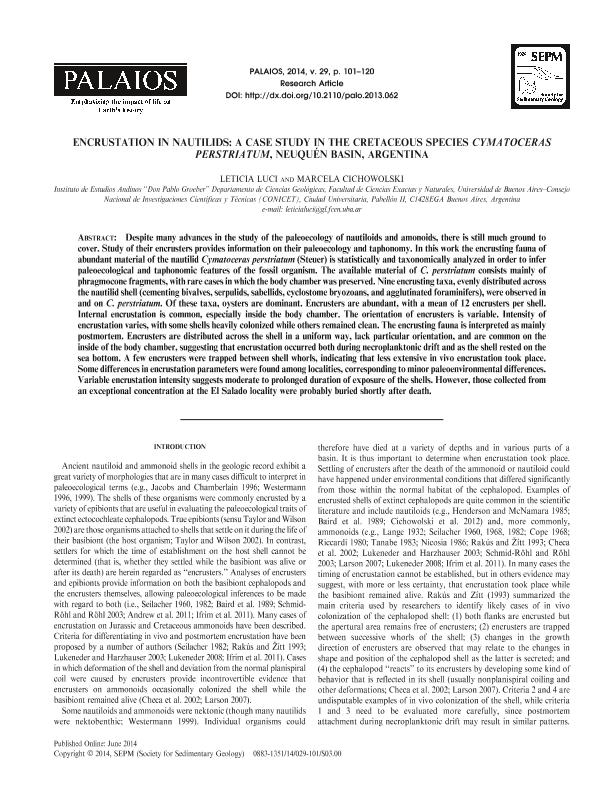Mostrar el registro sencillo del ítem
dc.contributor.author
Luci, Leticia

dc.contributor.author
Cichowolski, Marcela

dc.date.available
2017-06-19T18:38:18Z
dc.date.issued
2014-06
dc.identifier.citation
Luci, Leticia; Cichowolski, Marcela; Encrustation in Nautilids: a case study in the cretaceous species Cymatoceras Perstriatum, Neuquén basin, Argentina; Society For Sedimentary Geology; Palaios; 29; 6-2014; 101-120
dc.identifier.issn
0883-1351
dc.identifier.uri
http://hdl.handle.net/11336/18447
dc.description.abstract
Despite many advances in the study of the paleoecology of nautiloids and amonoids, there is still much ground to cover. Study of their encrusters provides information on their paleoecology and taphonomy. In this work the encrusting fauna of abundant material of the nautilid Cymatoceras perstriatum (Steuer) is statistically and taxonomically analyzed in order to infer paleoecological and taphonomic features of the fossil organism. The available material of C. perstriatum consists mainly of phragmocone fragments, with rare cases in which the body chamber was preserved. Nine encrusting taxa, evenly distributed across the nautilid shell (cementing bivalves, serpulids, sabellids, cyclostome bryozoans, and agglutinated foraminifers), were observed in and on C. perstriatum. Of these taxa, oysters are dominant. Encrusters are abundant, with a mean of 12 encrusters per shell. Internal encrustation is common, especially inside the body chamber. The orientation of encrusters is variable. Intensity of encrustation varies, with some shells heavily colonized while others remained clean. The encrusting fauna is interpreted as mainly postmortem. Encrusters are distributed across the shell in a uniform way, lack particular orientation, and are common on the inside of the body chamber, suggesting that encrustation occurred both during necroplanktonic drift and as the shell rested on the sea bottom. A few encrusters were trapped between shell whorls, indicating that less extensive in vivo encrustation took place. Some differences in encrustation parameters were found among localities, corresponding to minor paleoenvironmental differences. Variable encrustation intensity suggests moderate to prolonged duration of exposure of the shells. However, those collected from an exceptional concentration at the El Salado locality were probably buried shortly after death.
dc.format
application/pdf
dc.language.iso
eng
dc.publisher
Society For Sedimentary Geology

dc.rights
info:eu-repo/semantics/openAccess
dc.rights.uri
https://creativecommons.org/licenses/by-nc-sa/2.5/ar/
dc.subject
Encruster
dc.subject
Nautilid
dc.subject
Cretaceous
dc.subject
Taphonomy
dc.subject
Necroplanktonic Drift
dc.subject.classification
Paleontología

dc.subject.classification
Ciencias de la Tierra y relacionadas con el Medio Ambiente

dc.subject.classification
CIENCIAS NATURALES Y EXACTAS

dc.title
Encrustation in Nautilids: a case study in the cretaceous species Cymatoceras Perstriatum, Neuquén basin, Argentina
dc.type
info:eu-repo/semantics/article
dc.type
info:ar-repo/semantics/artículo
dc.type
info:eu-repo/semantics/publishedVersion
dc.date.updated
2017-06-19T17:27:04Z
dc.journal.volume
29
dc.journal.pagination
101-120
dc.journal.pais
Estados Unidos

dc.description.fil
Fil: Luci, Leticia. Consejo Nacional de Investigaciones Científicas y Técnicas. Oficina de Coordinación Administrativa Ciudad Universitaria. Instituto de Estudios Andinos "Don Pablo Groeber". Universidad de Buenos Aires. Facultad de Ciencias Exactas y Naturales. Instituto de Estudios Andinos ; Argentina
dc.description.fil
Fil: Cichowolski, Marcela. Consejo Nacional de Investigaciones Científicas y Técnicas. Oficina de Coordinación Administrativa Ciudad Universitaria. Instituto de Estudios Andinos "Don Pablo Groeber". Universidad de Buenos Aires. Facultad de Ciencias Exactas y Naturales. Instituto de Estudios Andinos ; Argentina
dc.journal.title
Palaios

dc.relation.alternativeid
info:eu-repo/semantics/altIdentifier/doi/http://dx.doi.org/10.2110/palo.2013.062
dc.relation.alternativeid
info:eu-repo/semantics/altIdentifier/url/http://palaios.sepmonline.org/content/29/3/101
dc.relation.alternativeid
info:eu-repo/semantics/altIdentifier/url/http://palaios.geoscienceworld.org/content/29/3/101
Archivos asociados
